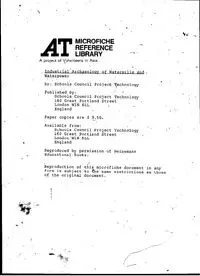
Industrial Archaeology Of Watermills And Waterpower History 1975 PDF
Preview Industrial Archaeology Of Watermills And Waterpower History 1975
1 . m Q 6 AT MlCROFlCiiE REFERENCE tlBRA,RY -‘* A project of yolunteers in Asia 3 . , Industrial'Archaeolosy of iatermills and p Wateroower -. by :’ School‘s Council .Project-.yT$xhnology Published by: . . . . s Schools 'Council Project 'Technology _ 160 Great Portland Street London WlN 6LL 3 . England Paper copies are $ 9.50,' i , 1 . d I Available from: '. - Schools CouncildProject Technology ' 160 Great Portland Street ' + >. London'WlN 6LL England . Reproduced by permission of Heinemann Educat'ional.Books. . ‘e ! 0 I Reproduction of this microfiche document in any form is subject to the'same restrictions as those j of the original document. : , ._ ‘- n ‘“, ’ P’ i “,‘,..’ - : :_; ;‘. .~ ‘I , -,- ‘. “r (_! . -; -” . . , 1 . . Project kchnology Handboohdll ” . . - ’ -\ r 9 r TRIm ’ . ARC fiEOlOGY ~ OP UJ#rmflilllS tL UJCITERPOUJER‘ Heinemann Educational Books / Schools Council 9 B r i ontents Foreword Introduction ’ \ 1 Industrial archaeology of watermills I 1 Htstory of waterpower 1.7 HistoT of corn milhi& 1.3 Corn mill watercourses c 1.4 Types of waterwheel I 5 Thr arrangement and equipment 01 \vatrrmills for corn milling 1.6 Index to milling and waterpower trrms 2 A school approach IO watermills 1.1 Locatron of mill sites 2.1 History of a particular mill 2.3 Plannmg work to achirve obJ2ctives 1.4 Instructions for us2 on sit2 3.5 Introductory informati,on 2.6 Work on site ‘7 -. Classifying and ordering information 2.8 Possibilitiej for further work 2.9 Class Discussion of findings 2.10 Relatmg particular aspects to the general picture 3.1 1 Watermill survey questionnaire 3 Water turbines 3.1 Early turbmss 3.2 Otli2r turbine dsvel.opments 3.3, Hydro-electric applications 4 Bibliography 4.1 Further reading 4.2 _ Publications on watermills in particular ar2as I i 1 2 -7 10 16 18 33 41 - q 43 43 45 r 47 49 : 54 55 56 61 71 12 82 85 85 88 97 . 97 97 98 ‘s..__ Te;chnological activifies are nqw firmly?s%bfished ifi many sc1~ools. They have been introduced ” bJ diverse methods, but they are here to stay - an? to devElEp-f%rther, given the help of publicationssuch as this. * - -- Sometimes teachers turn to Project Technology .publicaGons for general guide~es,,,at;othe~~.~.~~~- ,‘<,,. .,I Ire specific- aUl~J.ce”Some.teachersaini’r~ ‘fiij’f%“;&‘a’&dy of knowledge+ while ,..,_ _.._ _....... c- jncerned to develop in theirstudents antattitude of mind and technological * know-how im;aluable in problem solving. Sometimes technological Bctivities have originated in scienct: departments, so?xximes in school workshops, but usually they have developed 5 ’ to e’mbrace or touch upon every department of the school. The whole range of teaching material producea by Project Tetihnologyptended to help teachers achieve the balance -. =- nnmrxl iKtheiYzscho61s, -- ..--L-=_ ~_ -_ . These publica.tions play a vital role in realizing the central aims of Project Technoldky to see ’ I that all3tudents become aware of the technological forces of significance for society, to gibe . as many students as possible opportunity to become involved in the technological desigli process, and IO help them push forward the frontiers of their own technological resources in , terms of-borh theoretical knowledge and practical skills. Many people, ‘barticularly those responsible for the diversity of activities in the regional groi~ps of Project Technology; have played impbrtant parts in developing and writing teaching 9 case of Indztsrrial Arc+aeology of Watermills hnd Waterpower (and its lume, hzdzu-trial Archaeology f& Sclzools) we are indebted to Mr Geoffrey Starmer, d of the Education Uiiii at Lanchester Pblytechnic (Rugby), and now a Senior Northamptonshire Education Departm&, {or developing and ,writing up this material. ,S--=-- 7 .- - . . ,eoloa for Sc,4ools showed how a general approach to industrial archaeology can : = link science, iechnical, and arts subjects within’ the school in a way that helps to bring these”” j - i ( subjects alive in the context of-the community, past and present, around the school. A wide spectrum of past industrial
